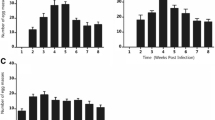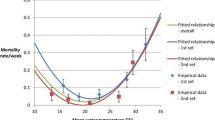Abstract
The developmental time ofSchistosoma haematobium inBulinus truncatus snails (field strains) was determined in the laboratory at different constant temperatures between 18 and 32°C. The basic relationship between the length of the minimum prepatent period (y, in days) and the temperature (x, in °C) is given by the hyperbolic formulay=295/(x-15.3), 15.3 being the theoretical “developmental null point” and 295 the constant time-temperature product. The shortest prepatency was 17–19 days at 30, 31 and 32° C; at 18° C, cercarial development required at least 106–113 days. The maturation time frequently exceeded the possible minimum by several weeks. No schistosome matured in our experiments at 17° or 33° C. The cercarial release per snail at weekly exposures showed a maximum at 25°C with a geometric mean of 109 cercariae (95% confidence limits 79–149), decreasing to 8 (2–30) at 18° C and 62 (38–100) at 32° C. The absolute maximum of cercariae shed by one snail during 5 h “stimulation” was 2,150 in a 25° C batch, 48 at 18° C and 529 at 32° C. The epidemiological application, the prognosis of the transmission period and the estimation of the transmission potential in relation to climatic conditions are discussed.
Similar content being viewed by others
References
Anderson RM, May RM (1979) Prevalence of schistosome infections within molluscan populations: observed patterns and theoretical predictions. Parasitology 79:63–94
Barlow CH (1939) Seasonal incidence of infestation of the snail hosts with larval human schistosomes. Am J Hyg 30:73–81
Chu KY, Dawood IK (1970) Cercarial transmission seasons ofSchistosoma mansoni in the Nile Delta area. Bull WHO 42:575–580
Chu KY, Massoud J, Sabbaghian H (1966) Host parasite relationships ofBulinus truncatus andSchistosoma haematobium in Iran. 4. Effect of month of infection on cercarial-incubation periods ofS. haematobium andS. bovis. Bull WHO 34:135–140
Chu KY, Massoud J, Arfaa F (1968) Distribution and ecology ofBulinus truncatus in Khuzestan, Iran. Bull WHO 39:607–637
El Abdin AZ, Roushdy MZ (1977) Maintenance of the life cycle ofSchistosoma haematobium in the laboratory. Eg J Bilh 4:165–178
Gordon RM, Davey TH, Peaston H (1934) The transmission of human bilharziasis in Sierra Leone, with an account of the life cycle of the schistosomes concerned,S. mansoni andS. haematobium. Ann Trop Med Parasitol 28:323–415
Lee KL, Lewis ER (1977) Prediction of schistosome cercarial shedding with a physiologicaltime model. Int J Epidemio 6:161–167
Pitchford RJ, Visser PS (1965) Some further observations on schistosome transmission in the Eastern Transvaal. Bull WHO 32:83–104
Pitchford RJ, Meyling AH, Meyling J, Du Toit JF (1969) Cercarial shedding patterns of various schistosome species under outdoor conditions in the Transvaal. Ann Trop Med Parasitol 63:359–371
Pflüger W (1976) Ecological studies in Madagascar ofBiomphalaria pfeifferi, intermediate host ofSchistosoma mansoni. 1. Seasonal variations and epidemiological features in the endemic area of Ambositra. Arch Inst Pasteur Madagascar 45:79–1114
Pflüger W (1977) Influence de températures constantes et de températures variables sur la prépatence deSchistosoma mansoni et sur l'hôte intermédiaireBiomphalaria glabrata. Haliotis (France) 8:151–153
Pflüger W (1980) Experimental epidemiology of schistosomiasis I. The prepatent period and cercarial production ofSchistosoma mansoni inBiomphalaria snails at various constant temperatures. Z Parasitenkd 63:159–169
Pflüger W (1981) Experimental epidemiology of schistosomiasis II. Prepatency ofSchistosoma mansoni inBiomphalaria glabrata at diurnally fluctuating temperatures. Z Parasitenkd 66:221–229
Shiff CJ, Evans A, Yiannakis C, Eardley M (1975) Seasonal influence on the production ofSchistosoma haematobium andS. mansoni cercariae in Rhodesia. Int J Parasitol 5:119–123
Shiff CJ, Coutts WCC, Yiannakis C, Holmes RW (1979) Seasonal patterns in the transmission ofSchistosoma haematobium in Rhodesia, and its control by winter application of molluscicide. Trans R Soc Trop Med Hyg 73:375–380
Teesdale C (1962) Ecological observations on the molluscs of significance in the transmission of bilharziasis in Kenya. Bull WHO 27:759–782
Webbe G (1962) The transmission ofSchistosoma haematobium in an area of Lake Province, Tanganyika. Bull WHO 27: 59–85
Author information
Authors and Affiliations
Rights and permissions
About this article
Cite this article
Pflüger, W., Roushdy, M.Z. & Emam, M.E. The prepatent period and cercarial production ofSchistosoma haematobium inBulinus truncatus (Egyptian field strains) at different constant temperatures. Z. Parasitenkd. 70, 95–103 (1984). https://doi.org/10.1007/BF00929579
Accepted:
Issue Date:
DOI: https://doi.org/10.1007/BF00929579




